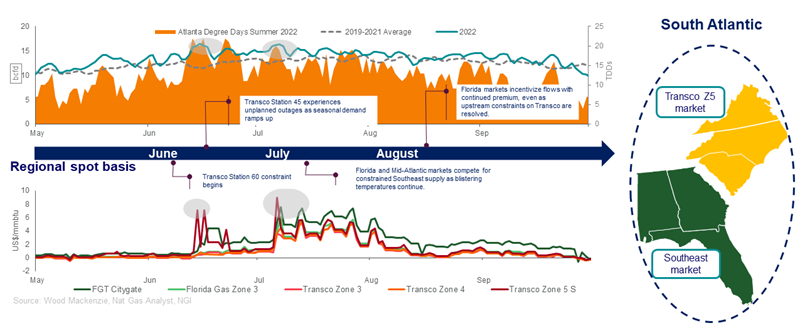What is the impact of the Mountain Valley Pipeline (MVP) on shifting South Atlantic gas price dynamics?
Evaluating the regional fundamental outlook and ongoing risks
2 minute read
Daniel Myers
Senior Research Analyst, North America Gas

Daniel Myers
Senior Research Analyst, North America Gas
Daniel delivers short-term fundamental modelling and regional market analysis.
Latest articles by Daniel
-
Opinion
Basin to bayou: finding gas for the coming growth in the US Gulf Coast
-
Opinion
LNG Canada makes historic first export shipment
-
Opinion
US natural gas storage: spring inventories surge
-
Opinion
Will summer heat help gas power burns overcome price and renewable headwinds?
-
Opinion
Cameron LNG maintenance highlights fragility in spring gas demand
-
Opinion
Gas prices set the stage for a shifting summer market
The South Atlantic region experienced significant volatility during summer 2022 due to extreme heat, unexpected pipeline constraints and higher than normal dependence on natural gas power. This time last year, Transco pipeline maintenance, ahead of a significant early summer heatwave, resulted in one of the most memorable South Atlantic gas market basis dislocations in recent memory.
In a recent webinar hosted by the North American gas team, we explored South Atlantic market dynamics in detail, including regional forecasts for supply, demand and pipeline flows, as well as the expected impacts from the start-up of the Mountain Valley Pipeline (MVP) project. Fill out the form to watch the replay or read on for a quick introduction to some of the themes discussed.
Summer 2022: a memorable market dislocation
The events of summer 2022 underscores a unique feature of the South Atlantic gas market, which is dependent on new infrastructure projects amid growing peak demand requirements.
Both Southeast and Transco Z5 markets saw significant demand surges as a result of the June 2022 heat wave, setting a seasonal record. Flows to the Southeast market were coincidentally constrained due to pipeline maintenance at Transco Station 60. Summer flows were reduced by about 0.5 bcfd due to the capacity limitation. Sonat saw the most flow changes along with other marginal suppliers for the region. Lack of adequate firm contracting on some of the incremental pipes (such as Gulfstream) drove up transport cost for the marginal supply, fuelling the basis spikes at market zone receipt points.
Will MVP alleviate price spikes in the South Atlantic market?
The inclusion of Mountain Valley Pipeline (MVP) permitting in the recently passed Fiscal Responsibility Act (FRA) implies that relief is on the way for at least a portion of the supply-constrained region. However, MVP start-up is not a cure-all, and our outlook suggests diverging price risks for the Transco Zone 5 and Southeast market regions.
MVP start-up is expected to begin easing summer pricing pressure on northern portions of the Transco Zone 5 market. However, Southeast markets will see sustained price risks to the upside in coming summer seasons due to supply competition with the Gulf Coast and additional demand growth.
Almost 1 billion cubic feet per day (bcfd) of new debottlenecking projects will bring more supply into the Transco Zone 5 market in 2024-2025. However, the Southeast market remains a demand island that competes for supply on existing pipelines coming into the market and most new projects focus on last-mile connections.
Regional fundamental outlook and forecast
The power sector drives gas demand growth in the South Atlantic, and natural gas dominates the South Atlantic power generation fuel mix. The region continues to add gas-fired power capacity, but renewable penetration will impact power burns to the downside starting mid-2030s.
Southeast basis points will be very sensitive to changing market dynamics including demand, capacity constraints, price risks and infrastructure.
Lessons learned from 2022 suggest that weather remains the wildcard, and reliance on natural gas for peaking demand requirements will only grow in the Southeast over the next decade. Unexpected pipeline maintenance and inadequate contracting levels can also drive tighter basis in periods of high demand.
Get further insight into the outlook for MVP
Watch the webinar replay for detailed analysis of the MVP and shifting South Atlantic gas price dynamics, including a range of charts and data.







